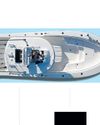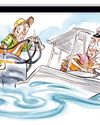
It's a celebrated item on restaurant menus around the globe. There are so many ways to prepare it-boiled, baked, stuffed, curried, thermidor, in a roll-and it's always delicious, though ordering it usually requires paying a rather outsize bill. But the great thing about lobster is that, in the right places, you can catch it and cook it yourself.
First of all, there's not just one type of lobster. Sure, the most well-known is the two-clawed American (or Maine) lobster found along the coast of New England and Canada. But there's also the California spiny lobster found on the West Coast, and the Caribbean spiny lobster found in Florida and the Caribbean islands. Fortunately, we have expert advice on how to catch all three from your boat. Start melting some butter.
WEST COAST
Hoop-Netting at Night
California spiny lobsters represent a hot commodity in more ways than one. The state's commercial landings hover anywhere from 650,000 to 950,000 pounds each sixmonth season. Yet it's hard to find a California spiny lobster in a US fish market or restaurant. That's because of skyrocketing demand for these delectable crustaceans in Asia, France and elsewhere.
Though they might grow to 20 pounds, most California spiny lobsters are much smaller, usually around 2 pounds. Unlike the American lobster, spiny lobsters have no claws. Most are caught in the warmer waters of Southern California below Point Arguello, and many seafood aficionados claim the tail meat is the most succulent of all lobster species.
That's why most California spinys caught in commercial traps are shipped to gourmet outlets overseas, where diners gladly pay a premium for some of the world's tastiest seafood. If you can find a lobster to buy here, you'll pay dearly. Retail prices in the US for live California spiny lobster at press time ranged as high as $40 per pound.
Esta historia es de la edición March 2023 de Boating.
Comience su prueba gratuita de Magzter GOLD de 7 días para acceder a miles de historias premium seleccionadas y a más de 9,000 revistas y periódicos.
Ya eres suscriptor ? Conectar
Esta historia es de la edición March 2023 de Boating.
Comience su prueba gratuita de Magzter GOLD de 7 días para acceder a miles de historias premium seleccionadas y a más de 9,000 revistas y periódicos.
Ya eres suscriptor? Conectar

AFFORDABLE SATCOM
Communications devices using satellite technology are more abundant today than any time in the past. What's more, many are portable, ultra-compact, affordable relatively and designed for boating, dispelling any perceptions that you need a big, expensive dome antenna aloft to access satellite communications.

IN THE BEGINNING
REPOWERING FOUNTAIN HULL NO.1

NAVICO GROUP FATHOM 2.0
Engine charging at 48 volts could be a game-changer.

PROPS FOR INNOVATION
Sharrow MX3 propellers live up to most of the company's performance-improvement claims.

MERCURY RACING 500R
Supercharged power for a variety of boats.

FLIPPING THE SWITCH
Much reporting focuses on reasons why one might choose electric marine power. The issues of range, speed, noise levels, winterizing and ethanol challenges, lake restrictions, environmental concerns and more all must be resolved on an individual basis. Little gets said about how a boater choosing to repower with electric actually gets that accomplished. Is it DIY? And if not, how does it get done?

TOW-VEHICLE TECH
If it's been a while since you bought new tow vehicle, you might be surprised by the many built-in advancements in trailering technology. New tow tech ranges from integrated weight scales and adaptive suspensions to systems that automatically back up your truck to hitch up your trailer. Here are a few examples to look for. -Jim Hendricks

MONUMENTAL TIPS FOR BACKING A TRAILER
Three Boating greats offer advice for a perennial reader query.

STICKING POINTS - Anchoring alternatives, and why you will always need a traditional anchor.
My brother-in-law likes to fish offshore reefs, and the process once entailed navigating to a mark, dropping a float, and idling upwind or up-current to drop the anchor in hopes the set would drop us back to the float.

FOR WANT OF A CLAMP
When 100 miles from shore, home and help, this boater’s preparedness prevented potential catastrophe.